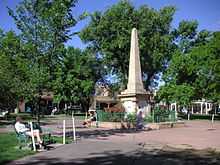Santa Fe Plaza
|
Santa Fe Plaza | |
 | |
| Location | Santa Fe, New Mexico |
|---|---|
| Coordinates | 35°41′13.9″N 105°56′14.99″W / 35.687194°N 105.9374972°WCoordinates: 35°41′13.9″N 105°56′14.99″W / 35.687194°N 105.9374972°W |
| Built | 1609 |
| Governing body | Local |
| NRHP Reference # | 66000491 [1] |
| Significant dates | |
| Added to NRHP | October 15, 1966 |
| Designated NHL | December 19, 1960[2] |
The Santa Fe Plaza is a National Historic Landmark in downtown Santa Fe, New Mexico in the style of traditional Spanish-American colonial cities. The plaza, or "city-square", was originally, and is still to this day, the center gathering place in town. Many know it as "the heart of Santa Fe". The landmark has since grown into a playground for many tourists interested in Spanish, Native American, and Mexican cultures, and includes music, design, jewelry, art and dance. Known to locals simply as the "Plaza," it is home to annual events including Fiestas de Santa Fe, the Spanish Market, the Santa Fe Bandstand, and the Santa Fe Indian Market.
Listed on the National Register of Historic Places, the Plaza consists of a central park lined with grass, trees, and benches, which add to the cultural scenery, especially at Christmas time when the Plaza streets and buildings glow with farolitos and the occasional luminaria, and trees glow with lights. Included in the park is an American Indian War Memorial monument as well as a performing arts stage.
Encompassed in the general Plaza area are historic monuments, restaurants, businesses and art galleries, including the Palace of the Governors (the oldest public building in the U.S.), the New Mexico Museum of Art, Cathedral Basilica of Saint Francis of Assisi, and the Loretto Chapel. In true pueblo fashion, the Plaza architecture is traditional adobe. Just 16 miles (26 km) from the Santa Fe ski basin, the Plaza dates back to the early 18th century when Santa Fe was settled by conquistadors. Until the mid-19th century, the Plaza lacked landscaping, and ownership of the area transitioned between the Spaniards and the Mexicans throughout the earlier years.

Historical context
Santa Fe Plaza has been the commercial, social and political center of Santa Fe since c. 1610 when it was established by Don Pedro de Peralta. The original Plaza was a presidio (fort) surrounded by a large defensive wall that enclosed residences, barracks, a chapel, a prison and the Governor's palace. Eventually the wall gave way to large houses built by high-ranking Spanish officers and officials. In 1822 the famed Santa Fe Trail, a trade route from New Mexico to St. Louis, was opened with its terminus in the Plaza. Today the Plaza is ringed by structures in the Pueblo, Spanish and Territorial styles that reflect its diverse history. Among the most noted are the original palacio, the Palace of the Governors, built between 1610 and 1612 and San Miguel Mission, a noted landmark c. 1640, and one of the oldest churches in the United States.[3]
The Plaza is Santa Fe’s historic, cultural and geographic center. In the early days, it was found at the end of El Camino Real (the Spanish Royal Road from Mexico City), the Santa Fe Trail, and the Old Pecos Trail. Today, the Plaza is surrounded by restaurants, shops and museums and it serves as a gathering place for both locals and tourists. Many seasonal community events are held at the Plaza, and it is then filled to capacity with people enjoying the magic that is 'The City Different'.[4]
Observations
The Santa Fe Plaza is a relatively small urban park, visited by 100,000 visitors annually. It is used for over a half-dozen events per year, drawing another 25,000 people and causing considerable impact on the plaza landscape.[2]
References
- ↑ "National Register Information System". National Register of Historic Places. National Park Service. 2007-01-23.
- ↑ 2.0 2.1 "Santa Fe Plaza". National Historic Landmark summary listing. National Park Service. Retrieved 2008-06-26.
- ↑ Santa Fe Plaza-American Southwest-A National Register of Historic Places Travel Itinerary
- ↑ Santa Fe Unlimited | Santa Fe Plaza
External links
| ||||||||||||||||||||||||||